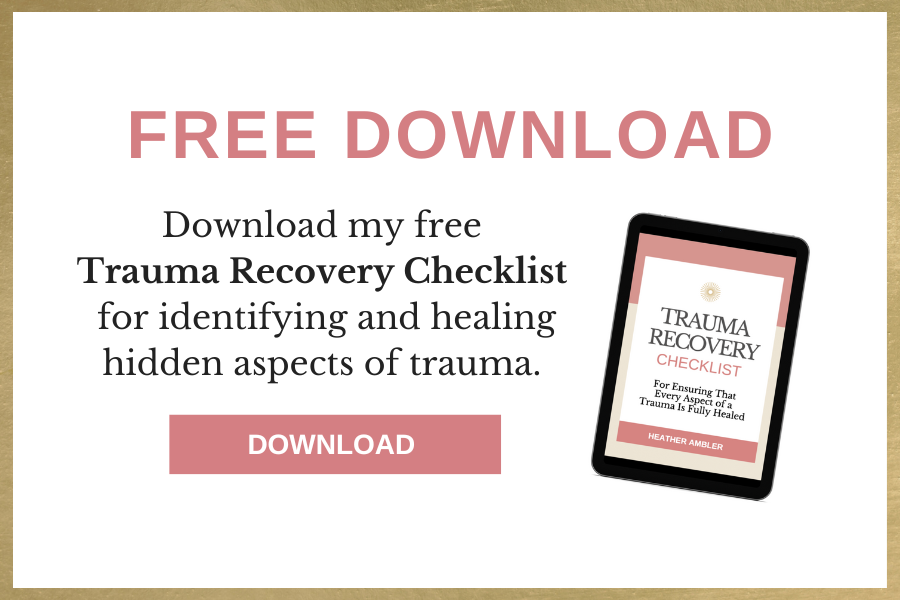My Two-Step Process for Using EFT Tapping to Release Fears
- Heather Ambler
- Feb 7, 2024
- 6 min read
Updated: Oct 8, 2024

When my daughter was little, she went through a phase during which she was terrified of Halloween. The thing that scared her about it the most was all of the monster masks and costumes that we seemed to see everywhere we went, from the local drugstore to our favorite bakery. Throughout the weeks leading up to Halloween, whenever we were at a store of just about any kind, she would clutch my arm with a white knuckled grip, while walking with her eyes closed, to make sure she didn't accidentally see anything frightening. Now she's all grown-up, and is no longer afraid of Halloween's ghouls, ghosts, or goblins. But every year as Halloween approaches, and I see all of the scary sights everywhere, I think of her frightened face pressed against me, and her small hands squeezing me as tightly as she could as I made my way around whatever store we happened to be in.
In a word, it's fear, fear, fear, that I'm constantly reminded of at this time of year, and since Halloween is traditionally about spirits, witches, spiders, and other things that generally scare the daylights out of people, what better time than now to face (and release!) the things that scare you?
So today I'm going to walk you through my two-step process for helping clients release fears. You may have already read my previous article about how to use EFT to release fears, and if so, I encourage you to read this one, as well, because it's a deeper dive into how to identify the roots of a fear, unpack the whole thing, and then tap it away.
STEP 1: Identify and Heal the Root Cause of the Fear
Every fear is rooted in something. Sometimes it's a traumatic event, sometimes it's a belief, and sometimes it's a combination of both. In order to release the fear, you have to identify and release what gave rise to it. The best way to do that is with questions.
Here's the first question I typically ask when working with a client to release a fear: If there was a reason why you have this fear, what would it be? Super simple, I know, but the simple route is often the most efficient way to get to your destination. Sometimes my clients are able to answer this question, and sometimes they aren't. When they are, we're off to the races! When they aren't, I have to do some more investigative work (which I'll get into below). Here are some examples of things clients have said about their fears:
I'm afraid of water because I was adrift at sea in a small boat for over a month.
I'm afraid of the dark because of what my step-father used to do to me at night.
I'm afraid of flying because I was on a flight that had major turbulence, and I thought we were going to crash.
If you're able to answer this question about a fear, thereby identifying the traumatic event(s) that caused the fear, then you just need to tap out the trauma(s), and usually the fear will go with it. If, after tapping out the trauma, the fear is still there, then try finishing this sentence by filling in the blanks: I'm afraid of _____________ because ______________. For example: I'm afraid of flying because the plane might crash. Then assess the intensity of that statement, and tap it down to a zero. If, after tapping that statement to zero, the fear of flying is still there, complete the following sentence by filling in the blanks. I'm afraid of the plane crashing because ___________________. Possible answers might be: I'm afraid of the plane crashing because I don't want to die. I'm afraid of the plane crashing because I'm afraid it will be painful. I'm afraid of the plane crashing because it would be so traumatic. Any answer to this question that has a charge to it is tappable, meaning that it indicates an aspect of your fear (or related trauma) that needs to be healed.
Other Powerful Questions for Uncovering the Roots of a Fear
This is one I turn to again and again in my work with clients:
How old were you when you first had this fear? For example, a client who was afraid of balloons popping identified her earliest memory of this fear as being at age 4. She had been at a pizza parlor which gave away balloons to the many children who were there, and it seemed that every few minutes, somewhere in the restaurant, a balloon would pop.
While she was there with her family, she suddenly came down with the flu, including a fever, headache, and vomiting. When I asked her how old she was when she first became afraid of balloons popping, and she told me, and also explained the circumstances, I had a hunch that in her feverish little child's mind, the sound of balloons popping had become unconsciously linked with feeling terribly sick, so I had her test the statement: "Popping balloons make me sick." Though the statement didn't make rational sense to her, it resonated with her as her emotional truth, and had a charge of 8. We tapped that statement down to 0, then tapped out a few related statements, and once we did that, her fear was gone. Presto! In case it's helpful to you, here are some of the other statements we tapped down to 0 in order to completely release the fear. A lot of balloons were popping the night I got sick at Shakey's. The sound of balloons popping really upsets me. Popping balloons give me a headache and a fever. I never want to hear the sound of a balloon popping ever again. When I got sick at Shakey's I felt horrible and very scared. The night all those balloons were popping at Shakey's, my parents had to take me home right away and put me to bed. If the question, "How old were you when you first had this fear?" doesn't help you get to the root of it, try this one: What does this thing that you're afraid of remind you of? For example, I had a client who was afraid of public speaking, and when I asked her this question, she said that it reminded her of being at the dinner table when she was growing up, where her father would quiz her about current events.
When she didn't know the answer or got an answer wrong, he would berate her in front of the rest of her family. Until I asked her that question, she hadn't realized that public speaking was associated in her mind with those upsetting dinner table experiences. However, every time she did public speaking or even thought about it, those traumatic memories were unconsciously triggered, causing all of the resulting fear, shame, embarrassment, and anger to come flooding through her body-mind. She also reported both fearing and resenting her audiences, though until this association was uncovered, she hadn't known why. Once we used tapping to release the pain from those painful memories dinner table memories, they could no longer trigger painful emotions and fear around public speaking, and she was able to do it with confidence and relative ease (no pun intended). Additional statements we used to release related aspects of the fear were: I hate public speaking. Public speaking makes me feel like everyone is judging me.
Public speaking feels like a test that I'm going to fail. I'm afraid I'm going to be criticized if I say the wrong thing. Public speaking feels like punishment.
STEP 2: Test It
To make sure a fear is truly gone, I recommend testing it with statements like the following:
1) I'm afraid of _____________ (insert the fear you're working on).
Test this statement by asking yourself the following question:
Does that feel true for you? If the answer is yes, you've got more tapping to do.
2) I wish I wasn't afraid of ____________.
Like the previous statement, if this one feels charged or true (or both), you've got more tapping to do, and you can begin with this statement.
3) I want to feel comfortable and safe around _____________. Again, if this statement feels charged and brings up fear, your tapping work isn't finished. If this statement (and the previous ones) feels neutral, you're good to go.
Additional Testing Method
You can also test whether you've completely released a fear by using visualizations. How do you feel in the presence of the thing you're afraid of? Imagine it as vividly as you can, and if it brings up fear, that's a clear indication that you've got more tapping to do.
PLEASE NOTE
W hen doing EFT tapping on your own, if you get stuck, aren't able to completely heal the issue(s) you're working on, or would simply would like to have the support and guidance of an experienced professional, I recommend working with an EFT practitioner. If you decide that this is the best course of action for you, and you'd would like to work with me, click here to schedule an EFT session or free consultation.
BY HEATHER AMBLER
Heather Ambler is a California based EFT practitioner and mindset coach. Through her private practice and online programs, she’s helped many thousands of people all over the world heal the pain of losing a loved one, recover from trauma, release fears, erase limiting beliefs, increase confidence, and achieve goals. If you could use some help with any of these things, click here to schedule an EFT session or free consultation.




































































































































